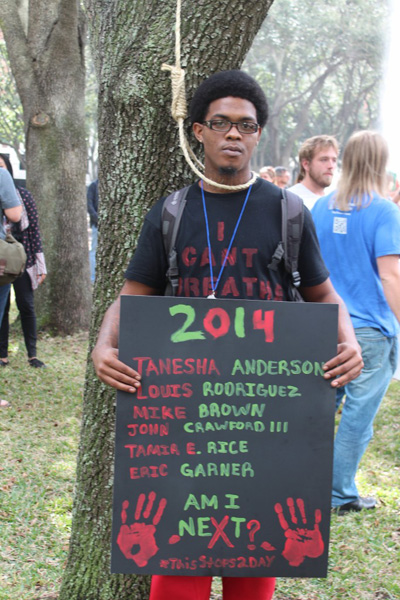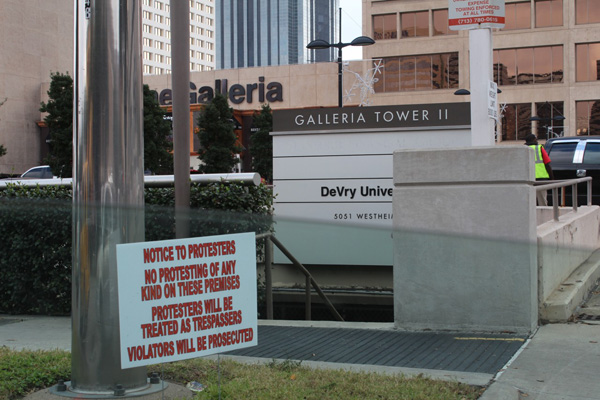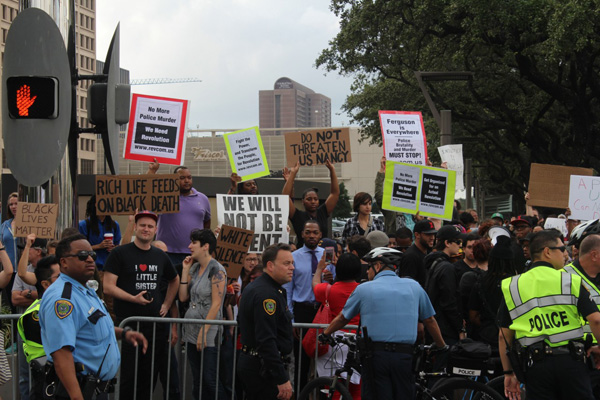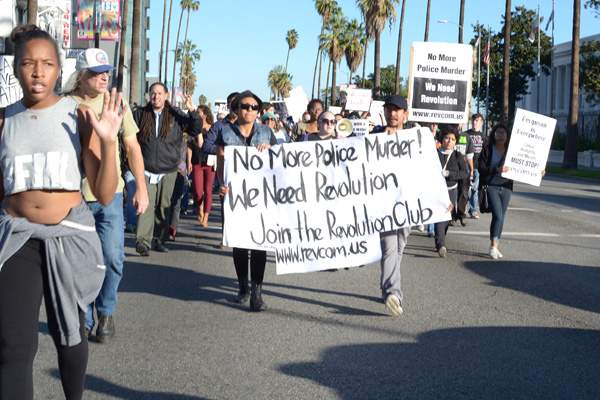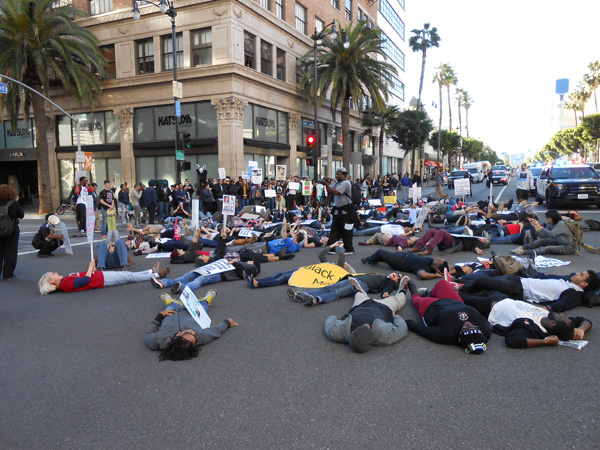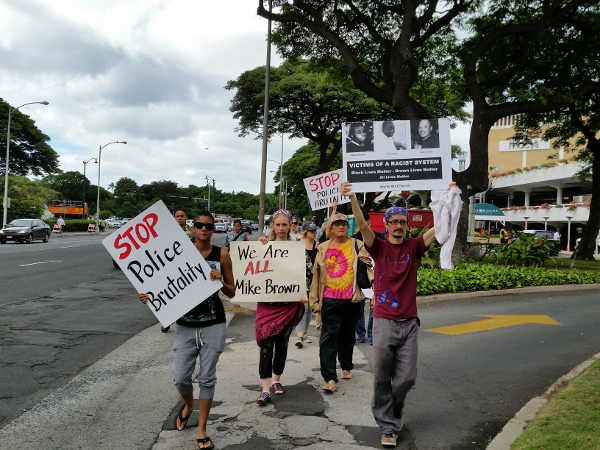December 13: Tens of Thousands March Across the U.S. Against Police Murder
Updated December 16, 2014 | Revolution Newspaper | revcom.us
Saturday, December 13, tens of thousands converged on Washington, DC for the "National Justice For All March." Protests also marked the day in dozens of other cities around the country, including tens of thousands in New York City. Other cities with protests include Los Angeles, Chicago, San Francisco-Oakland, Houston, Boston, and more. There was also a large police presence at these protests, and reports of multiple arrests in Chicago, Boston, Houston, and Oakland.
In Washington, DC, parents and other family members of people killed by police lined the front of the stage. In NYC the march, starting at 2 pm in Manhattan, was still marching at 11 pm in Brooklyn after having crossed the Brooklyn Bridge.
Below are initial reports of the day from some of the cities. Stay tuned to revcom.us for more.
Washington, DC
From a correspondent:
Over 10,000 people of all nationalities joined in the March for Justice called by Al Sharpton's National Action Movement. A large majority of the crowd was made up of Black people from the DC, Maryland, and Virginia region, many of whom had not participated in protests in the past, but who felt compelled to speak out against the seemingly endless waves of murders of young Black men and even children at the hands of the police who are never punished.
Fear for themselves, their children, their brothers, along with sorrow, frustration, and anger at the all-around injustices facing Black people today, were the frequent reasons given for turning out.
There was also a smaller but substantial section of white people—high school and college students as well as religious groups, professionals, and others who felt a deep responsibility to speak against the way in which most white people still go along with this. Many carried signs like, "White silence=complicity."
While there was a great deal of lame reformism from some speakers at the rally, there were also powerful speeches including ones from a defiant fighter from Ferguson and from an organizer of the highway takeovers in DC, who spoke to and captured the anger and uncompromising spirit of the people who are in the streets now. There were also deeply moving speeches from a number of family members of those whose lives have been stolen by the police—mothers, fathers, spouses, children of people like Eric Garner, John Crawford, Tamir Rice, and Amadou Diallo. These speakers expressed tremendous determination to keep fighting and deep love and appreciation for the protesters around the country and the marchers who have given voice to their loved ones who can no longer speak for themselves—and this love was warmly reciprocated by the crowd.
In this scene, the "We Need Revolution" contingent was welcomed by many, many people. Many people were drawn to march behind its banner reading, "Police Brutality and Murder Must Stop. We Need Revolution." Well over 100 took up signs with similar slogans. People around the contingent joined in chants like "Indict, convict, send the killer cops to jail, the whole damn system is guilty as hell." Close to 1,000 copies of Revolution newspaper, as well as many palm cards for the video of the November 15 Dialogue between Cornel West and Bob Avakian got out.
New York City
From a reader:
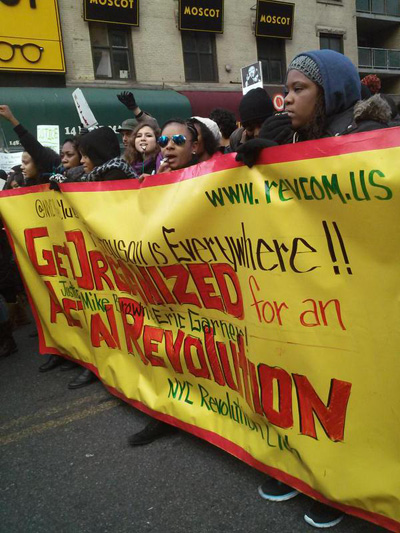
Photo: Special to revcom.us
Tens of thousands of protesters formed a river of people pouring out of Washington Square and flowing rapidly up Fifth Avenue in Manhattan. Very diverse in background, and unmistakably young in character and energy – students from high schools, colleges and universities and youth in general carried much of the day's fast-paced march. Huge creative banners read: This Stops Today; Black Lives Matter; Stop Killing Our Friends; Real Thugs Wear Flag Pins.
Helicopters hovered overhead and police lined the avenues with gates, vans and huge white Corrections Department buses. A highly repressive, mass-incarcerating torture state—that is tormenting the very environment needed for life—saw fit to keep its pig apparatus on display today. This was not done in the most naked and brutal way used against the brave and defiant ones in Ferguson. But make no mistake, NYPD's top voices are blatantly asserting in the pages of New York's newspapers their right to murder with impunity.
One Black woman college student who came with a group of friends from different schools said, "We need to convict these cops… If you're never going to jail behind killing an unarmed kid you are not going to stop. Here we are—losing youth in large numbers. What kind of state of mind will we end up in if we let this go on? This is unacceptable."
From another reader, phone report from middle of the march:
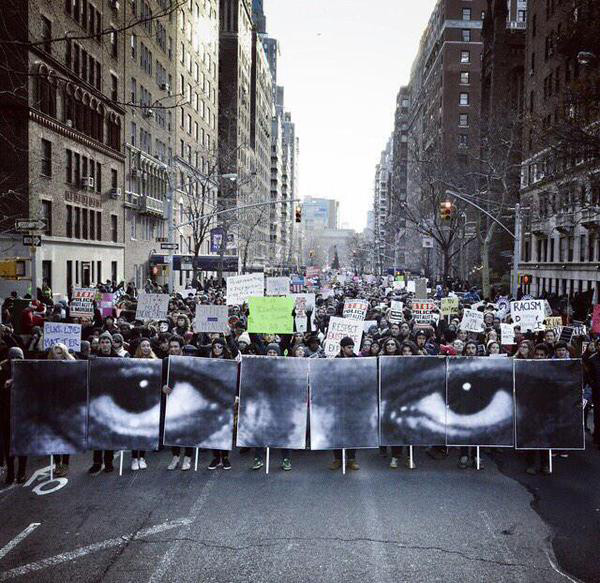
Photo: Special to revcom.us
I’m with a handful of folks with the Revolution Club and they are running with the Stop Mass Incarceration Network that began prepping a few hours before the march. The march stretches at least 28 blocks.
Got out a lot of posters that read “Ferguson is Everywhere. Justice for Michael Brown and Eric Garner. Police Brutality and Murder MUST STOP! www.revcom.us." The largest banner was "Get organized for an actual revolution. NYC Revolution Club.” Also there were two dozen high-school-aged students who have held up the banner and called out the chants: "What’s the problem—the whole damn system. What’s the solution? Revolution!"
I asked one of the students, what you think the ultimate solution would be to this kind of problem? The response was along the lines of: shutting down the U.S. society and making everyone notice, bringing an awakening and more consciousness.
An older gentleman who has taken a leading role said he met the Revolution Club around organizing for this year's October 22 National Day of Protest to Stop Police Brutality, Repression, and Criminalization of a Generation. He was disenchanted with lots of the organizations that he had seen, and had become more and more convinced that we need revolution to answer police brutality. He was really impacted by Bob Avakian's quote from his book BAsics, “There would be no United States as we now know it today without slavery. That is a simple and basic truth.”
This is one of the most varied demonstrations that I have seen, especially on police brutality. Lots of children, mothers carrying their babies, huge core of teenagers. I asked a group of five women that were walking along the sidewalk what they thought—they were five Black women from Detroit visiting, and they said that justice should be for everyone and the police should not have privilege, and they should be accountable.
Later on Saturday, a section of the march went over the Brooklyn Bridge from Manhattan to Brooklyn—and then marched in Brooklyn for hours into the night. Next day, Revolution/revcom.us talked to two people who were part of that march.
1. S, Black woman from Staten Island, active with the Stop Mass Incarceration Network
Revolution/revcom.us: Tell us what happened in the march.
S: What happened was, when we got to the Brooklyn Bridge, the police tried to stop us. The people said—and it was the youth—we're not going to stop, and they went through the police. The police couldn't stop them. There was a lot of police—but they still didn't stop them. And I followed. There were hundreds of people at that point—because even at the end, it was like 300, so it was much more than that at that point. They not only took over the traffic on one side of the bridge, then they went over and stopped the traffic on the other side. At one point, the police did grab somebody, but I was pleasantly surprised, because the cops were extremely non-confrontational…
Whoever was there, I hooked up with them. I was first with a group from Staten Island called NAAPS, that's North Americans Against the Police State, and they have a t-shirt that says "Don't Shoot I'm Human" or "Don't Shoot, I'm Black." The I ended up with the Light Brigade of New York and they had signs that says "Black Lives Matter" or "Fire Bratton" or "Justice."
We went over the bridge. There really was no direction, right? But we just kept on going—going into the traffic, going into the traffic. The police would cut us off at the bend and so we would go another direction.
The youth were extremely motivated. Then they decided to go to the Pink Houses [housing projects in Brooklyn] where Akai Gurley was killed by cops [on November 20].
Revolution/revcom.us: Before that, you went down Eastern Parkway, a major street in Brooklyn, and stopped traffic.
S. Yes we did. We stopped traffic every-where we went. And we got a lot of extremely good reception from the motorists. They would honk their horns, they would take flyers, put their fists up, hold out their hands to high five. Don’t get me wrong—there were a few who were not feeling us. But we were not deterred.
At one point, it seemed like people were getting tired. But the youth were saying: Don't you dare give up! We've come so far. Don't you dare get on that subway. So we kept on going.
Revolution/revcom.us: Where were the youth from—who were they?
S. It was the youth from the streets. Some didn't even know each other. I talked to different youth. They didn't know how to do mike checks, so I taught them how to do mike checks. And they got the hang of it.
Revolution/revcom.us: What were the youth saying? Why were they out in the streets?
S: They were talking about "No justice, no peace, no racist police." There's this song, and I wish I could remember how it went—but it was something like: I hear my brother crying, "I can't breathe." We have to deal with these racist police. We're not gonna give up till we are free. And they kept singing it over and over and over. There was this little girl—she was only six years old, with her mother. She was singing—and she was louder than some of the older people! There were youth from the Bronx, Brooklyn, Manhattan. They went on the Internet and they saw, and they just wanted to partake… They just kept on going and going and going. People were just riled up, and they just wanted to keep on going. They were working so well together. I thought they knew each other—but they didn't. They were just marching and saying, "We've had enough, we're tired of the racist police, the racist system. They were very receptive to me—I gave them information about the Stop Mass Incarceration Network…
There was a sister in the march who was making statements—she said she was related to Ramarley Graham [18-year-old youth who was killed by police in the bathroom of his own house in the Bronx in 2012]. She said she was still devastated by what took place, and what continues to happen. She doesn't want it to keep on going on.
At certain times we did die-ins, and people would make different testimonies and say how they felt about what was happening. We also stopped in front of one of the police precincts. And that got confrontational with the police. One sister asked, "Why do you go and come out, and instead of shoot to wound, you shoot to kill?" She was asking them that. Of course they didn't give no answer… The youth were just so angry, so angry. But it's being directed in a positive way. They are very well aware that it's hard out there. Because they're from Brooklyn, they're from the Bronx, they're from the streets where it's happening. And so they say, "No, we're not going to be deterred." I would say there were about two-thirds of the protest that was the youth. And I have to hand it to them. They kept me going. Because, I'm telling you, I was aching—but my mind was still strong.
2. O; Black man from Brooklyn—his two sons were killed by police
Revolution/revcom.us: Tell us what you saw.
O: When I got off the train at West 4th Street [in Manhattan], and found my way around, one thing I saw that was good was the variety of people from many walks of life. So what that said to me was that, something had happened that had hit the vein or the core of people of many walks of life. Or it hit the soul of people, to put it that way. There was a common denominator that many people felt, for the things that had happened regarding the grand jury decisions not to indict the police… What it showed me was that there was a cry from the heart and the souls—the stones were crying out. The base root of people's souls were saying, what was done to let the police get away with it, and for the legal criminal justice system to permit it and allow for it to happen—that was a crime…
The protest on Saturday said that people are tired, and they're not going to take it anymore. I loved to see the many-cultured, many-aged…it was just a variety of people. We said we're not going to take it anymore. We said Black lives matter. Because the decision by the grand jury was that Black lives do not matter. They said it in Missouri. They said it in Staten Island. And they said it with Trayvon, even though that wasn't a police issue but it had to do with police state of mind—that a person can take on the authority of a police person. So all I'm saying is that people were saying from all walks of life on Saturday, this is wrong.
Revolution/revcom.us: Where did you march?
O: I didn't know I had it in me, to be able to be standing here today, Sunday—after marching Saturday, from W. 4th Street to 32nd Street, back to W. 4th Street, from W. 4th Street to the Brooklyn Bridge, over the Brooklyn Bridge, all the way to Linden Blvd. in the Pink Houses—and then back to New Lotts Ave.
Revolution/revcom.us: What happened at the Pink Houses?
O: We got to the Pink Houses, thank god. We stood in front, and we read the names and said "rest in peace" of so many victims, including Akai Gurley—he was the first we read. Then they read the names of eight women who were killed by police. That really touched me… This protest Saturday was necessary, at a very important time, to prepare us for 2015 and on.
Revolution/revcom.us: Another person we talked to who was at the march said there were a lot of young people there.
O: Yes, there was a lot of young people. As a matter of fact, we picked more up as we went through the projects. As we went through the projects in Brownsville. As we went through the projects in Cypress Hills. As we went through the projects in the Pink Houses. Each place we went to, we said to them, "Come on out." And they came on out. What is that saying? It's saying that the democratic process is broke. And that's a profound statement because—the democratic process has to do with the Democrats and the Republicans, the so-called electoral voting process. It's telling us that we have people in office that we're paying to kill our kids?! I don't think so! No! I'm not paying no police to kill my two sons--or anybody else's family members and/or to run into the projects and get children…children! I marched with this six-year-old boy and her mother, and that really motivated me. It reminded me of my two sons. We have to train our kids, inform them that you're very important. I saw other people with their children there. That's very enlightening. Why? Because it tells us that there is a future. And the show of force of people from gray-haired, middle aged, young people—it shows us that somebody in that electoral process is wrong, that people are being lied to and going along with the lie. But this is saying that, you know what, we're not going to go along with the lie no more. They don't want to be deceived no more… The police force—they're monsters. They're demonic monsters.
Chicago
From a reader:
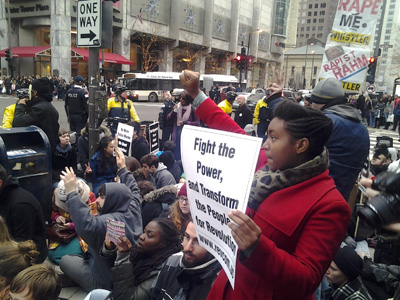
Photo: Special to revcom.us
At 1pm on Saturday, December 13, an overwhelmingly young and very multinational crowd began to gather at State and Jackson in downtown Chicago as part of the National Day of Protest against police terror. There were some short speeches and then the march took off, but not before the Chicago Revolution Club marched in as a contingent led by a banner proclaiming “Fight the Power, and Transform the People, for Revolution. Chicago Revolution Club—Revcom.us.” And the whole march had a very radical edge. Revolutionaries and Stop Mass Incarceration Network (SMIN) members worked with other groups who played a very dynamic role throughout the march. Some people brought homemade signs, many carried SMIN signs, and all the posters from www.revcom.us were grabbed up too, including by a woman who put down the poster she had been carrying because it seemed “too wimpy” in comparison. There were a lot of new people on the march, and there was a lot of love among them as they expressed their determination that police terror has to end.
There was a massive showing of Chicago pigs who were aggressive and vicious. Early on, the mc of the rally from SMIN and two others were arrested for stepping out into the street. And as the march continued, the police jammed people back onto the sidewalk. One foot in the street got another person arrested. But the march was not deterred.
Two young members of the Chicago Revolution Club were targeted for vicious attack by the pigs outside the Nordstrom’s store on Chicago’s Magnificent Mile upscale shopping area. News coverage shows the woman being wrenched toward the police van with her arms being pulled backward and upward. The young man is reported to have suffered a broken nose and several lacerations to his face. He is facing a bogus felony charge of assault on a police officer, and $75,000 bail, as is another protester. We demand the charges be dropped against all those protesting police murders.
Once over the Chicago River, at the south end of the “Magnificent Mile” of Michigan Avenue, teeming with Christmas shoppers, a die-in was staged for four and a half minutes—one minute for each hour that the pigs let Michael Brown’s body lay in the steaming street where he had been shot down and murdered—by around 400 demonstrators. The shoppers moved into the street to pass by. Many joined the march after it stepped off, as it covered a good two city blocks heading north. The march stopped again at the north end of the Mag Mile, across from Macy’s, where a tense stand-off took place as the march strove to cross the street. Blocked by the police, the demonstrators staged another die-in at this major intersection, packed with holiday shoppers. During the four and a half minutes, an eerie silence befell the entire area, not just among the demonstrators. It was as if time stood still, and the mad dash to obey-consume-repeat was halted for a reflective moment.
The march lasted over four hours. At one point it headed south again, to Nordstrom’s department store. While some people held a big “Stolen Lives by Police Murder” banner in front of the store entrance, a number of marchers zipped in and staged a die-in. The police soon realized what was going on and swooped in after them—arresting at least 11 people. More arrests and vicious assaults on the crowd were made back on the street where the pigs grabbed several people, including a young woman from the Revolution Club, and viciously beat another young Revolution Club member who has been very active in the protests. These young revolutionaries were targeted by the police. (See box.) All told, 23 people were arrested and three people are facing felony charges. (One of the felonies was reduced to a misdemeanor on December 14.)
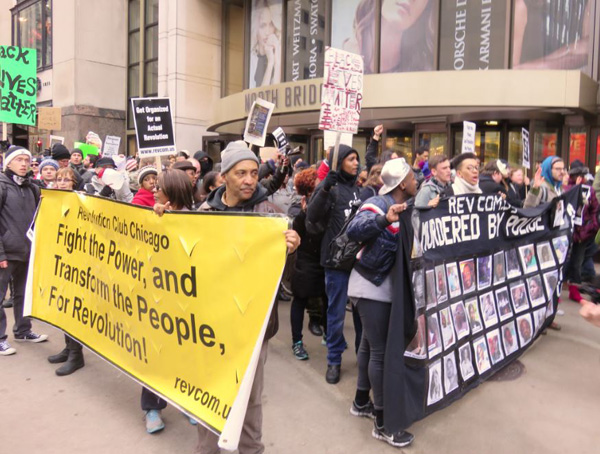
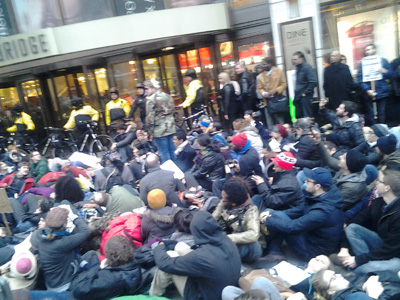
Photos: Special to revcom.us
These outrageous attacks did not go down unopposed. The police department got so many calls condemning their actions that they resorted to not even talking to people, instead just making stupid sounds. Nordstrom’s also must have thought twice about their role in this because they refused to press charges against all those arrested in their store. Supporters immediately went to the police station where people were being held to demand their release, staying till after midnight. As of this writing, several of those arrested on misdemeanors have been released on their own recognizance. And right now people are planning to pack the bond court Sunday, December 15, when the two still facing felonies will be arraigned.
Update December 14: Bail was set at $75,000 for each person with a bogus felony charge, which requires posting $15,000 in order for them to be released from jail. One of the people facing a felony charge is from the Revolution Club. He is well-known to the Chicago police for his role in the protests since the pigs walked in the murders of Mike Brown and Eric Garner. Contact Revolution Books Chicago to find out how to donate to the bail fund.
San Francisco Bay Area
From readers:
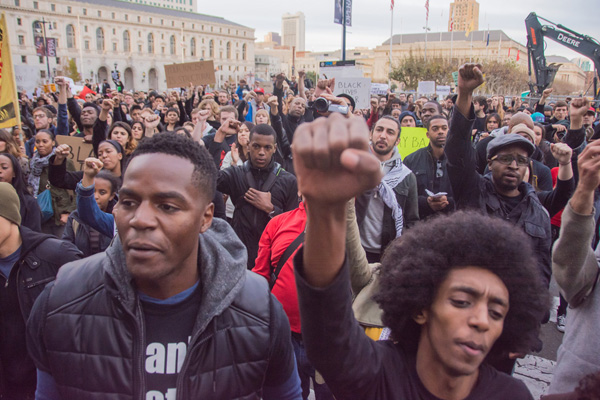

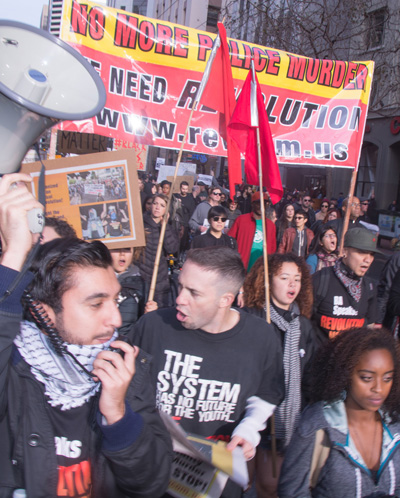
San Francisco. Photos: Special to revcom.us
Thousands marched in the SF Bay Area as part of national demonstrations against police brutality and murder, called by “Millions march,” a “Day of Anger because Black lives matter.”
There were major protests in both downtown San Francisco and Oakland. In San Francisco, an estimated 4,000-5,000 people marched down Market Street, the main street in downtown San Francisco. The entire downtown was at a standstill because of the march, as a broad and diverse group of protesters took over all of the broad avenue, stretching for blocks. This was a very carefully controlled march, flanked on both sides by hundreds of police. People who wanted to enter the march from the sidelines had to go through police lines, at least near the front. Chants of “Black lives matter” as well as many others from the weeks of protest echoed through San Francisco streets. Banners and signs reflected different political organizations, as well as unions and church groups. The movement for revolution was represented by many signs throughout the march, and also several large banners, including “No More Police Murder—We Need Revolution. www.revcom.us” and a banner from the Revolution Club.
The march was very broadly supported by many, many people along the way. Comments ranged from Black people eagerly voicing their support for the march, in some cases with angry calls for revolution when asked what they thought the solution to police murder is; to firm supporters of the march from a wide range of nationalities; to white people with large holiday shopping bags near high-end department stores thoughtfully making clear that they support the cause of equality, and understand that it does not exist in America today, while at the same time hesitating to say exactly what they thought of the grand jury verdict in the Eric Garner and Michael Brown cases. And a few who mumbled about “riots,” echoing media distortions of the protests to date.
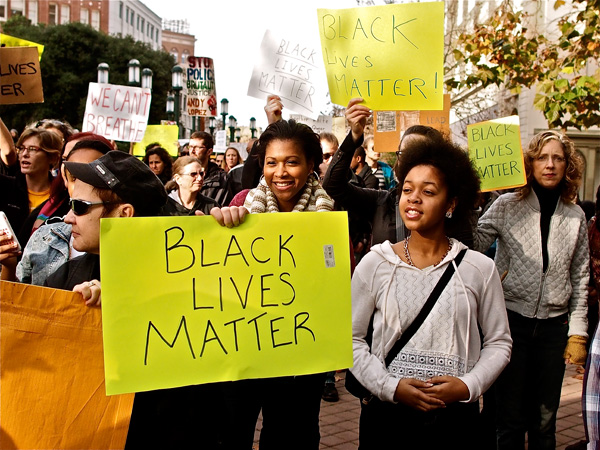
East Oakland. Photo: Special to revcom.us
The march started at the Ferry Building on the San Francisco waterfront and ended up at City Hall, where there was a rally. As the rally was breaking up, the Revolution Club called for people to continue to march, and hundreds joined, marching back down Market Street to the main shopping area in SF centered on Powell and Market. At one point, police blocked the march and threatened the protesters. There were hundreds of shoppers watching, and some had joined, including some in Santa Claus outfits. An agitator on a bullhorn called on shoppers to support the march against police threats. Many, many shoppers raised their hands and chanted “hand up, don’t shoot,” a moving and powerful display. The agitator at one point called out “If you refuse to live like this, let me see you raise your fists” and at least 50 people on the streets behind police lines raised their fists. The cops, who had probably 400 hundred cops mobilized to follow this demonstration, eventually declared an illegal assembly; people were still in the street as we sent off this report.
In Oakland, about 3,000 people gathered at Oscar Grant Plaza in downtown Oakland. There was a contingent of students from UC Berkeley, at least several hundred, that marched from the University, down Telegraph Avenue, to Oakland.
After a rally at 14th and Broadway, the group marched to the County Courthouse on Fallon St., near Lake Merritt. Again, a massive force of police was mobilized to contain the march.
As we are writing, some are continuing to march while others have left.
St. Louis-Clayton, MO
From readers:
About 125 people gathered at Hickey Park in North St. Louis to march to the Hall Street Work House (i.e., jail). The crowd was multi-national and all ages. Drummers, women in orange jail suits, and the stolen lives banner led the march. This was one of the first marches here to speak to mass incarceration and the millions of men and women locked up. It also happens to be one of the jails holding many of the courageous protesters from the Ferguson uprising.
As we marched to the jail chanting "let them go" people rushed the fence and began calling the prisoners to come to the window. Many did, shouting "No Justice no Peace." They spoke of the demand to be free. One ex-prisoner spoke of the horrific condition, while brothers inside shouted "this is a shit hole." Unsanitary conditions, fights just to get food, healthy inmates locked up with people with tuberculosis. Infection rampant throughout the jail. A rally was held at the fence with the bullhorn toward the prisoners. People spoke of the millions behind bars, how the "war on drugs" had put many in jail for long sentences and the demand that all the people arrested be immediately released.
At the end of the rally one of the organizers of the protest read the Stop Mass Incarceration Network pledge and people joined in. People left the jail and marched to a major intersection and held a die-in. Many people along the way honked and people came out of their homes to get Revolution newspaper and other information about mass incarceration.
The day before people staged the "Circus of Injustice" downtown with about 150 people marching all throughout the downtown streets and to the courthouse to deliver the demands to the Dept. of In-Justice to prosecute Darren Wilson, the murdering pig who killed Mike Brown, an unarmed young Black brother. A large pink papier-maché pig with Darren Wilson's name on it was pushed toward the riot police guarding the court house. One of the riot cops had Wilson's name on his uniform. The march then went to Clayton High School for a short stop. A number of organizers came out with some students and marched into downtown Clayton. 70 students had walked out from here the week before.
Houston
From readers;
For the second time in as many weeks hundreds of people marched through an up-scale shopping district in Houston, Texas, bringing the message that Black Lives Matter and a deep-felt determination to STOP police murder and brutality to a broad array of people of all nationalities. The demonstration the week before had almost literally taken over the Galleria mall, and had attracted showings of interest and support from many shoppers. This time the police did everything they could to throw up a wall of repressive force and keep the fight for justice from reaching and inspiring yet more people. They set up signs all around the mall specifically warning that any protestors entering would be arrested.
In this situation there were ongoing efforts on the part of individuals and groups to find the ways to break protest out and stop business as usual. When a small number of young people did step into the street the cops viciously grabbed who they thought were the leaders, including putting one of them in a chokehold. People fought back, and were able to pull their fellow protesters to safety only to lose them again to thuggery by the police. In spite of the authorities' viciousness, people participated in a number of die-ins blocking entrance to shops and restaurants in the area.
The message of revolution got out through our Revolution—Nothing Less banner and the many signs with slogans like "No More Police Murder—We need a revolution" taken up by the crowd. Several dozen Revolution papers got out as well. But the question of the possibility as well as the necessity for revolution was quite controversial. We got out our invitation to the BA Everywhere celebration to everyone we spoke to,with the message that here would be a chance to get deeply into the burning questions people are confronting regarding what will it take to stop police murder, and all exploitation and oppression.
Los Angeles
From readers:
Several hundred protesters of many nationalities and all ages came together at Hollywood and Highland in righteous anger at the wanton police murders of unarmed Black and Latino people; but also with the joy of being a part of this powerful uprising taking place across the country. There was a short rally near the spot where, a week before, LAPD cops had gunned down a young white man in front of many people. People were invited to come to the microphone to speak. And then the march took off.
Among the speakers was Professor Jody Armour, Roy P. Crocker Professor of Law at the University of Southern California, who said that he was there because he has three sons and he’s had to think about this since they were 5, 6, 7 months old… that they’re profiling them in the cradle, and from the cradle to their grave. And he went on: "Talking goes so far. But we also gotta do, and part of doing is sticking your head in the lion's mouth and taking some risks. Taking risks when we see flagrant... you mean to tell me that wasn't a chokehold? Okay, enhanced interrogation isn't torture?... This is like Rodney King. We saw it with our own eyes.... People waited for justice. And when the justice system betrayed them, when the promise of justice was so flagrantly flouted, then we exploded in L.A.... This is a powder keg we're sitting on."
Someone from the Revolution Club spoke to the crowd as well, and said in part: "Today, and what we have been doing the last three weeks, all across the country, we have become a new people, that are saying 'No more!' That are not gonna put our heads down when they execute our people in the street. We're a new people, and we gotta take this higher, and we gotta take this farther…. They are showing us that the only thing their system’s got is their violence, and their bullets, and our fear. And we give up our fear today!" And the crowd took up the chant: "We give up our fear today."
The march took off in high spirits, chanting all along the 2+ miles route. Three times there were 4 ½ minute "die-ins" in the intersections along the way—to remember the 4 ½ hours Michael Brown’s body lay in the street.
The cops surrounded the demonstrators after the second die-in, and tried to make them disperse. Instead the marchers regrouped and took the street again, marching back toward the starting point. A block before Hollywood and Highland, the police completely surrounded the demonstrators, declared it an illegal assembly, and gave them 10 minutes to disperse, or face arrest. There was a third die-in. Then the police issued a threat to use violence, claiming the protesters had violated a penal code and that if people didn’t leave they would be arrested and if they regrouped again, they might get hurt. Then they listed all the weapons in their arsenal that they could use against the protest.
Boston
From a reader:
A crowd ranging from 1,500 to 3,000 people marched from the statehouse in downtown Boston to North Station with the goal of shutting down I-93, the interstate highway. "Shut this racist system down" was a popular chant among the crowd of mainly college students along with community activists and some ex-'60s people. Some Harvard students were there, just off a major march there the night before that shut down portions of Cambridge. Speakers shouted out the names of Black people killed by the police, including Bo Ramsey killed in 2012 in Boston. One professor spoke about being brought to tears over these grand jury rulings, and said she told her class that if they didn't feel that, then they needed to check their humanity.
Meanwhile an army of cops had been mobilized to block off access to the major highways, and when people tried to push through 23 were arrested. The march continued and rallied outside the Nashua St. jail. One prisoner put up a message on his window, "They beat up the inmates." And people chanted "we see you." The march went back to downtown and another "die-in" on Tremont St., the main thoroughfare. People grabbed up "Ferguson is everywhere" and "Fight the power, and transform the people, for revolution" posters promoting the www.revcom.us website, and many got papers and leaflets as well.
Honolulu, HI
From a reader:
About 30 people held signs at the entrance to the Waikiki tourists area, and marched around Ala Moana Shopping Center where thousands of people were doing their holiday shopping. An attorney related the story of her client, a man who was asphyxiated last year when four large policemen held him face down as he cried "I can't breathe." Die-ins held up traffic at two major intersections. Response from people driving by or on the sidewalk was awesome—with some stopping to share their stories of police brutality.
Cleveland
From a Reader:
Thirty of us—activists from Puncture the Silence (an affiliate of Stop Mass Incarceration Network), revolutionary youth and others—went into the West Side Market packed with people on Saturday morning. We went up to a balcony overlooking the market and did a banner drop. The banners said “Justice for Tamir” and “Justice for Tanisha Anderson,” two Black people killed by the police here in November. Then people sang a spiritual calling for justice and then chants of “Black Life Matters” rang out. People there, including many white people from the suburbs, looked up and took notice, many giving approving gestures.
Then we went to Tower City, the main downtown shopping area, and we did a die-in for 35 minutes. At one point, a revolutionary youth read the Stop Mass Incarceration Network “Pledge of Resistance” and then an activist did a mic check challenging people to think about the realities of life for Black people in this Christmas season. In a dramatic presentation, he said, “Merry Christmas Cleveland, ‘Jeez-us’ did you know the police can kill Black people with impunity?” He told me afterwards, “At Tower City people brought their children out for the Christmas fanfare. They were confronted with the element of reality and surprise. Disruption of the Christmas spirit is a huge piece of revolution. In the season of the solstice we must continue to remind people of the realities of the inequities, using the things they love to escape with to remind them what’s actually happening in our world.”
Then we got up and marched through the building chanting, and we got noticed. We heard parents telling their young children what the scene was all about. Hearing “Black Life Matters” a Black man said to one of us, softly and deeply, “Thank you.”
After this some of us went out into an area of the Black community putting up posters like, “No More Police Murder/We Need Revolution” and “Get Organized for an Actual Revolution.” And people checked them out, some agreeing with what they say. We agitated and got some Revolution papers out broadly and in stores. People who did the actions felt that even if small, we did impact hundreds of people with our message of “No More to Police Murder,” including for some of us revolutionaries, the message that this is an illegitimate system and we need to make revolution as soon as possible.
Volunteers Needed... for revcom.us and Revolution
If you like this article, subscribe, donate to and sustain Revolution newspaper.

